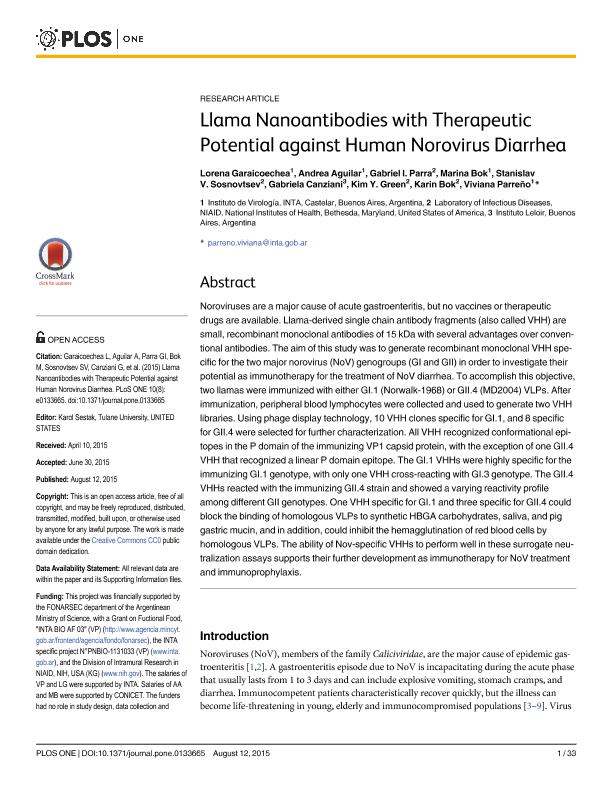Mostrar el registro sencillo del ítem
dc.contributor.author
Garaicoechea, Lorena Laura

dc.contributor.author
Aguilar, Andrea Pamela

dc.contributor.author
Parra, Gabriel I.
dc.contributor.author
Bok, Marina

dc.contributor.author
Sosnovtsev, Stanislav V.
dc.contributor.author
Canziani, Gabriela Alicia

dc.contributor.author
Green, Kim Y.
dc.contributor.author
Bok, Karin
dc.contributor.author
Parreño, Gladys Viviana

dc.date.available
2019-10-11T18:00:20Z
dc.date.issued
2015-08
dc.identifier.citation
Garaicoechea, Lorena Laura; Aguilar, Andrea Pamela; Parra, Gabriel I.; Bok, Marina; Sosnovtsev, Stanislav V.; et al.; Llama nanoantibodies with therapeutic potential against human norovirus diarrhea; Public Library of Science; Plos One; 10; 8; 8-2015; 1-33
dc.identifier.issn
1932-6203
dc.identifier.uri
http://hdl.handle.net/11336/85736
dc.description.abstract
Noroviruses are a major cause of acute gastroenteritis, but no vaccines or therapeutic drugs are available. Llama-derived single chain antibody fragments (also called VHH) are small, recombinant monoclonal antibodies of 15 kDa with several advantages over conventional antibodies. The aim of this study was to generate recombinant monoclonal VHH specific for the two major norovirus (NoV) genogroups (GI and GII) in order to investigate their potential as immunotherapy for the treatment of NoV diarrhea. To accomplish this objective, two llamas were immunized with either GI.1 (Norwalk-1968) or GII.4 (MD2004) VLPs. After immunization, peripheral blood lymphocytes were collected and used to generate two VHH libraries. Using phage display technology, 10 VHH clones specific for GI.1, and 8 specific for GII.4 were selected for further characterization. All VHH recognized conformational epi-topes in the P domain of the immunizing VP1 capsid protein, with the exception of one GII.4 VHH that recognized a linear P domain epitope. The GI.1 VHHs were highly specific for the immunizing GI.1 genotype, with only one VHH cross-reacting with GI.3 genotype. The GII.4 VHHs reacted with the immunizing GII.4 strain and showed a varying reactivity profile among different GII genotypes. One VHH specific for GI.1 and three specific for GII.4 could block the binding of homologous VLPs to synthetic HBGA carbohydrates, saliva, and pig gastric mucin, and in addition, could inhibit the hemagglutination of red blood cells by homologous VLPs. The ability of Nov-specific VHHs to perform well in these surrogate neutralization assays supports their further development as immunotherapy for NoV treatment and immunoprophylaxis.
dc.format
application/pdf
dc.language.iso
eng
dc.publisher
Public Library of Science

dc.rights
info:eu-repo/semantics/openAccess
dc.rights.uri
https://creativecommons.org/licenses/by-nc-sa/2.5/ar/
dc.subject
VHH
dc.subject
NANOBODY
dc.subject
NOROVIRUS
dc.subject
BLOCKING
dc.subject
HBGA
dc.subject
GI
dc.subject
GII
dc.subject.classification
Virología

dc.subject.classification
Ciencias Biológicas

dc.subject.classification
CIENCIAS NATURALES Y EXACTAS

dc.title
Llama nanoantibodies with therapeutic potential against human norovirus diarrhea
dc.type
info:eu-repo/semantics/article
dc.type
info:ar-repo/semantics/artículo
dc.type
info:eu-repo/semantics/publishedVersion
dc.date.updated
2019-10-08T12:12:31Z
dc.journal.volume
10
dc.journal.number
8
dc.journal.pagination
1-33
dc.journal.pais
Estados Unidos

dc.journal.ciudad
San Francisco
dc.description.fil
Fil: Garaicoechea, Lorena Laura. Consejo Nacional de Investigaciones Científicas y Técnicas; Argentina. Instituto Nacional de Tecnología Agropecuaria. Centro de Investigación en Ciencias Veterinarias y Agronómicas. Instituto de Virología; Argentina
dc.description.fil
Fil: Aguilar, Andrea Pamela. Consejo Nacional de Investigaciones Científicas y Técnicas; Argentina. Instituto Nacional de Tecnología Agropecuaria. Centro de Investigación en Ciencias Veterinarias y Agronómicas. Instituto de Virología; Argentina
dc.description.fil
Fil: Parra, Gabriel I.. National Institutes of Health; Estados Unidos
dc.description.fil
Fil: Bok, Marina. Consejo Nacional de Investigaciones Científicas y Técnicas; Argentina. Instituto Nacional de Tecnología Agropecuaria. Centro de Investigación en Ciencias Veterinarias y Agronómicas. Instituto de Virología; Argentina
dc.description.fil
Fil: Sosnovtsev, Stanislav V.. National Institutes of Health; Estados Unidos
dc.description.fil
Fil: Canziani, Gabriela Alicia. Consejo Nacional de Investigaciones Científicas y Técnicas. Oficina de Coordinación Administrativa Parque Centenario. Instituto de Investigaciones Bioquímicas de Buenos Aires. Fundación Instituto Leloir. Instituto de Investigaciones Bioquímicas de Buenos Aires; Argentina
dc.description.fil
Fil: Green, Kim Y.. National Institutes of Health; Estados Unidos
dc.description.fil
Fil: Bok, Karin. National Institutes of Health; Estados Unidos
dc.description.fil
Fil: Parreño, Gladys Viviana. Consejo Nacional de Investigaciones Científicas y Técnicas; Argentina. Instituto Nacional de Tecnología Agropecuaria. Centro de Investigación en Ciencias Veterinarias y Agronómicas. Instituto de Virología; Argentina
dc.journal.title
Plos One

dc.relation.alternativeid
info:eu-repo/semantics/altIdentifier/url/https://journals.plos.org/plosone/article?id=10.1371/journal.pone.0133665
dc.relation.alternativeid
info:eu-repo/semantics/altIdentifier/doi/https://doi.org/10.1371/journal.pone.0133665
Archivos asociados
